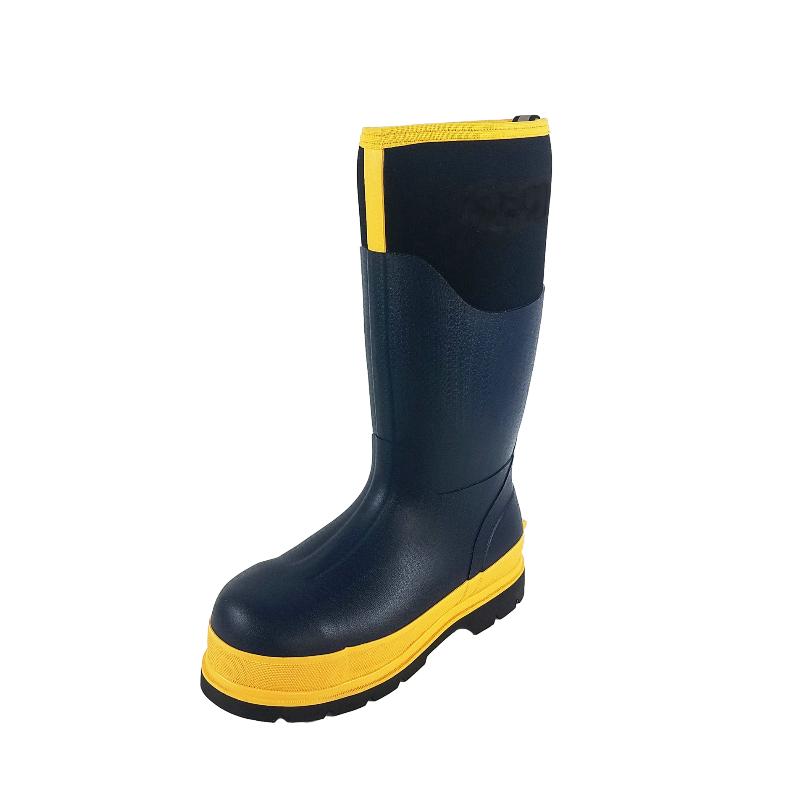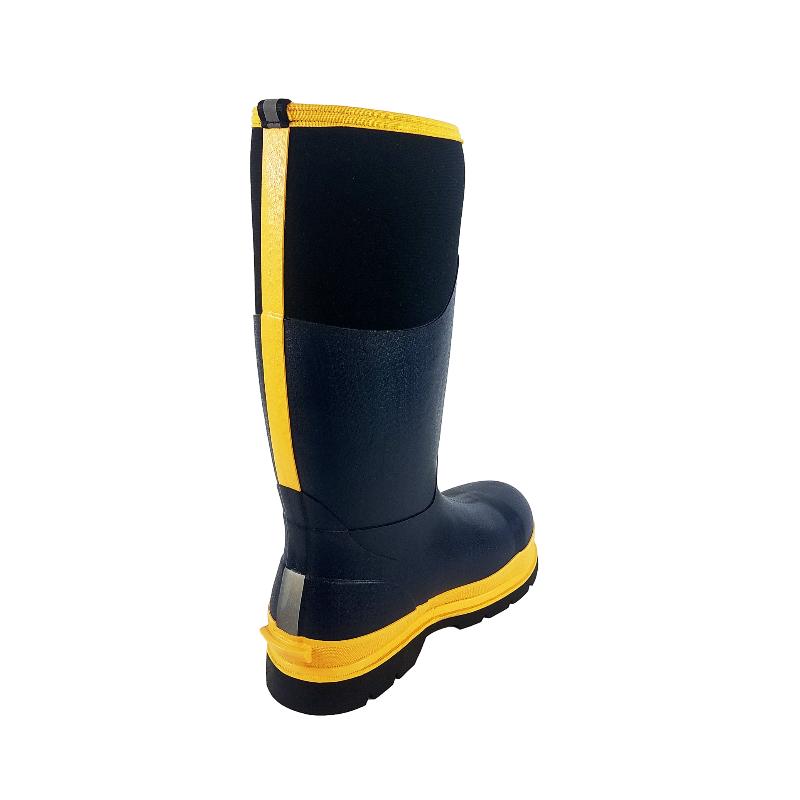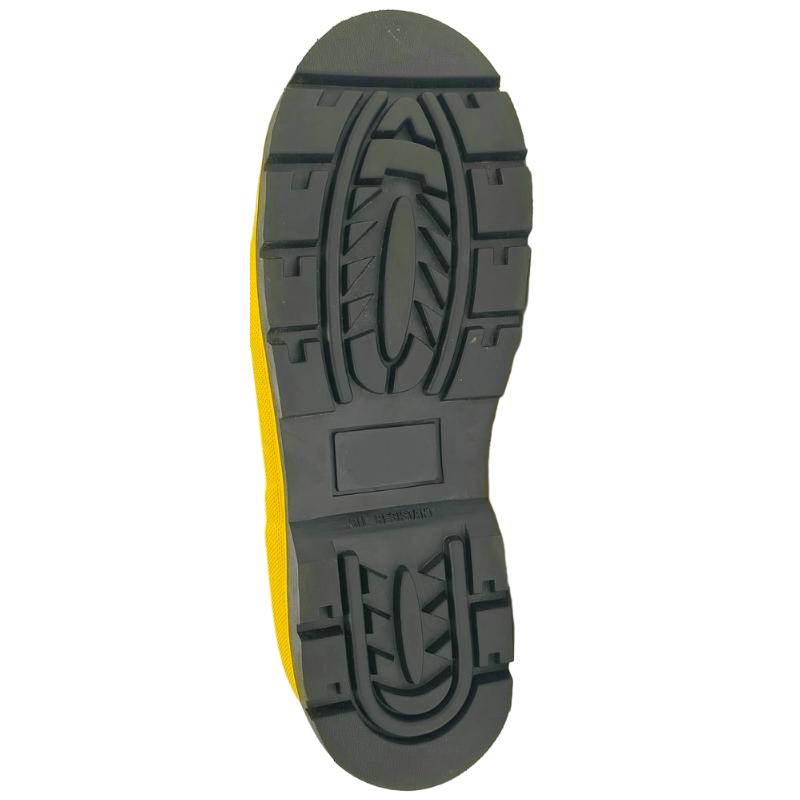In hazardous work environments, reliable personal protective equipment (PPE) is not merely a recommendation; it is a critical necessity. Among the most vital components of this equipment are safety boots, designed to shield workers from a myriad of risks including punctures, impacts, slips, and exposure to harsh chemicals. Traditional rubber or PVC boots often fall short in specific extreme conditions. This is where neoprene safety boots emerge as a superior solution, offering unparalleled protection and comfort. Our focus today is on the S5 Standard Neoprene Safety Boots SY02-18NS5 from Landwalk Outdoor, a product exemplifying the pinnacle of safety footwear technology.
The Evolution of Safety Footwear: Why Neoprene?
The industrial landscape is constantly evolving, demanding more robust and specialized PPE. Historically, leather and basic rubber boots served as primary safety footwear. However, the rise of chemical industries, offshore operations, and food processing environments highlighted the limitations of these materials, particularly regarding chemical resistance, thermal insulation, and flexibility in extreme temperatures. Neoprene, a synthetic rubber, was developed by DuPont in the 1930s and has since become a material of choice for demanding applications, including high-performance wetsuits, industrial gaskets, and now, advanced safety footwear.
Neoprene safety boots offer a unique combination of properties that make them ideal for hazardous conditions. They are renowned for their excellent resistance to oils, chemicals, acids, and alkalis, which is crucial in sectors like petrochemicals and agriculture. Furthermore, neoprene provides superior insulation against both heat and cold, ensuring comfort and protection in diverse climates. Its inherent flexibility allows for greater mobility and reduces wearer fatigue, a significant advantage over rigid boot materials.

Industry Trends and Demand for Advanced Safety Footwear
Current industry trends indicate a strong move towards specialized, high-performance PPE that addresses specific occupational hazards. There's a growing demand for boots that are not only robust but also lightweight, comfortable, and sustainable. The market for neoprene safety boots, including composite toe neoprene boots and safety neoprene wellies, is driven by stricter safety regulations globally, increasing awareness among employers about worker well-being, and the need to reduce workplace accidents. Companies are investing in better PPE to improve productivity, reduce absenteeism, and avoid costly legal liabilities. Innovations in material science are also contributing, allowing manufacturers to create boots that are stronger, lighter, and more adaptable.
Product Deep Dive: S5 Standard Neoprene Safety Boots SY02-18NS5
The S5 Standard Neoprene Safety Boots SY02-18NS5 are a prime example of Landwalk Outdoor's commitment to superior safety and comfort. This model adheres rigorously to the EN ISO 20345:2011 S5 standard, signifying the highest level of protection for professional footwear. This includes a 200-joule impact resistant toe cap (often composite toe neoprene boots for lightweight advantages), penetration resistance through the sole, anti-static properties, energy absorption in the heel region, and a cleated outsole for superior slip resistance. Furthermore, as S5 boots, they are fully waterproof.
Key Technical Parameters and Specifications
Understanding the technical specifications of neoprene safety boots is crucial for selecting the right footwear for specific environments. The SY02-18NS5 model incorporates a range of features designed for maximum protection and durability:
- Material Composition: High-grade Neoprene upper with natural rubber overlays for enhanced durability and chemical resistance. Inner lining for comfort and moisture-wicking.
- Toe Cap: Available with a robust steel toe cap (200 Joules impact resistance) or an advanced composite toe cap (lighter, non-metallic, excellent thermal insulation, ideal for environments with metal detectors like airports or sensitive electrical work).
- Midsole: Puncture-resistant steel plate or non-metallic anti-penetration sole (Kevlar/Textile based), providing protection against sharp objects from below.
- Outsole: Oil-resistant, slip-resistant (SRC rated), anti-static, and heat-resistant rubber outsole with deep lugs for superior traction on uneven and slippery surfaces.
- Height & Weight: Designed for full leg protection (typically knee-high), optimized weight for reduced fatigue during long shifts.
- Insulation: Exceptional thermal insulation due to neoprene, maintaining comfort in both hot and cold extremes.
- Chemical Resistance: Superior resistance to a wide range of industrial chemicals, acids, oils, and greases, making them indispensable in chemical processing plants.
- Compliance: Fully certified to EN ISO 20345:2011 S5 HRO SRC.
Comparative Analysis: Neoprene vs. Traditional Materials
To truly appreciate the advantages of neoprene safety boots, a comparison with traditional materials is insightful. The table below highlights key differences:
| Feature | Neoprene Safety Boots (e.g., SY02-18NS5) | PVC Safety Boots | Rubber Safety Boots (Standard) | Leather Safety Boots |
|---|---|---|---|---|
| Chemical Resistance | Excellent (Oils, Acids, Alkalis, Solvents) | Good (Limited against some strong solvents) | Good (Limited against some oils/solvents) | Poor (Degrades with chemical exposure) |
| Thermal Insulation | Excellent (Hot & Cold) | Poor to Moderate | Moderate | Moderate |
| Flexibility & Comfort | High, reduces fatigue | Low, stiff | Moderate | Good (after break-in) |
| Puncture Resistance | High (with anti-penetration sole) | High (with anti-penetration sole) | High (with anti-penetration sole) | High (with anti-penetration sole) |
| Weight | Moderate to Lightweight (especially composite toe neoprene boots) | Moderate to Heavy | Heavy | Moderate to Heavy |
| Durability & Lifespan | Very High (Resistant to abrasion, ozone) | Moderate | High | High (requires maintenance) |
| Typical Cost | Higher | Lower | Medium | Medium to Higher |
The Art of Crafting Protection: Manufacturing Process of Neoprene Safety Boots
The manufacturing of high-quality neoprene safety boots is a sophisticated process that combines advanced material science with precise engineering. It ensures that each pair meets stringent safety standards and provides optimal performance in demanding environments. Here's a detailed look at the typical process, highlighting key stages:
Material Preparation & Compounding
The journey begins with the careful selection and preparation of raw materials. High-grade neoprene rubber is compounded with specific additives, curing agents, and fillers to achieve desired properties such as flexibility, chemical resistance, and durability. Natural rubber might be compounded separately for the outsole, tailored for slip and abrasion resistance. Linings (e.g., moisture-wicking textiles like polyester or nylon jersey) are also prepared.
Pattern Cutting & Component Fabrication
Based on precise digital designs, the neoprene and lining materials are cut into various patterns for the upper, shaft, and footbed using automated CNC cutting machines for accuracy and minimal waste. At this stage, components like the steel or composite toe cap and puncture-resistant midsole plates are also prepared and shaped according to size specifications. The Landwalk SY02-18NS5, for instance, uses precision-engineered molds for its unique design.
Assembly of Upper & Lining
The cut neoprene upper pieces are carefully stitched or cemented together, forming the boot's shaft and foot enclosure. Simultaneously, the inner lining is assembled and seamlessly integrated, ensuring a comfortable fit and effective moisture management. This stage often involves skilled handwork combined with specialized machinery to ensure strong, waterproof seams.
Injection Molding / Vulcanization of Shell & Sole
This is a critical stage. For many modern neoprene safety boots, the outsole and sometimes even a lower rubber "shell" are created through injection molding. The pre-assembled neoprene upper is placed into a mold, and liquid rubber compound is injected under high pressure and heat, creating a seamless bond between the upper and the durable outsole. Alternatively, traditional vulcanization processes are used where the components are assembled and then cured under heat and pressure to create a single, durable unit. This ensures the boots are fully waterproof and highly resistant to chemical ingress.
Integration of Safety Components
Before or during the molding process, the prepared safety components – the 200-joule resistant toe cap and the anti-penetration midsole – are securely integrated into the boot structure. Precise placement is essential to ensure they offer maximum protection without compromising comfort or flexibility. This is where the distinction between traditional steel and lightweight composite toe neoprene boots becomes evident in terms of manufacturing assembly.
Finishing & Quality Control (QC)
Once molded, the boots undergo trimming, cleaning, and a series of rigorous quality control checks. This includes visual inspection for defects, physical testing for bond strength, water integrity (hydrostatic testing), slip resistance (using SRC standards on ceramic tile with NaLS and steel with glycerol), and impact/compression tests for the toe cap and midsole, adhering strictly to ISO 20345 standards. Only boots that pass all tests proceed to packaging.

Applications and Advantages: Where SY02-18NS5 Shines
The robust design and advanced material properties of the S5 Standard Neoprene Safety Boots SY02-18NS5 make them indispensable across a wide array of hazardous industries. Their technical advantages translate directly into enhanced worker safety, comfort, and ultimately, operational efficiency.
Typical Application Scenarios:
- Petrochemical Industry: Protection against corrosive acids, hydrocarbons, and oils. The superior chemical resistance of neoprene is paramount here.
- Mining & Quarrying: Safeguard against punctures from sharp rocks, impacts from falling debris, and excellent grip on uneven, muddy terrains. The S5 standard ensures comprehensive protection.
- Food Processing & Agriculture: Easy to clean, resistant to animal fats, oils, and various chemicals used in sanitation. The fully waterproof design is critical for hygiene.
- Construction & Infrastructure: Protection from falling objects, punctures, and stable footing on slippery surfaces. Ideal for outdoor work in varying weather.
- Utilities & Wastewater Management: Impervious to sewage and common wastewater chemicals, offering essential hygiene and chemical protection.
- Offshore & Marine Environments: Excellent grip on wet decks, resistance to saltwater, oils, and provides insulation in cold, damp conditions.
- General Manufacturing & Warehousing: Offers overall protection against impacts, slips, and spills in various industrial settings.
Technical Advantages in Action:
The SY02-18NS5 model offers distinct advantages that contribute to a safer and more productive work environment:
- Unmatched Chemical & Oil Resistance: Neoprene's inherent molecular structure provides exceptional resistance to a vast spectrum of industrial chemicals, acids, alkalis, and petroleum products. This prevents material degradation and ensures the boot maintains its protective integrity over time, unlike PVC or standard rubber boots which can stiffen, crack, or dissolve upon exposure. This leads to longer product lifespan and consistent protection, reducing the frequency of replacements.
- Superior Thermal Insulation: Whether working in sub-zero temperatures or hot, humid conditions, neoprene's closed-cell structure traps air, providing excellent insulation. This helps regulate foot temperature, preventing frostbite in cold environments and reducing discomfort from heat, thereby enhancing worker comfort and reducing fatigue.
- Exceptional Durability & Longevity: Neoprene is highly resistant to abrasion, tearing, and ozone degradation (cracking from UV exposure), which are common issues with other materials. This means neoprene safety boots have a significantly longer service life, even in harsh conditions, leading to cost savings over time for businesses. Landwalk Outdoor's boots are engineered for a typical lifespan of 2-5 years, depending on usage intensity and maintenance, significantly outperforming many alternatives.
- Enhanced Comfort & Flexibility: Despite their robust protection, neoprene boots remain highly flexible and comfortable, conforming better to the foot's natural movements. This flexibility reduces strain and fatigue during long shifts, directly contributing to increased worker productivity and morale. The S5 Standard Neoprene Safety Boots SY02-18NS5, for example, are designed with an ergonomic fit to minimize pressure points.
- Comprehensive Safety Compliance: Adherence to the EN ISO 20345:2011 S5 HRO SRC standard means these boots meet the highest international safety requirements. This includes features like 200J toe protection (impact and compression), puncture resistance (1100N), anti-static properties, energy absorption in the heel, and SRC-rated slip resistance, ensuring full compliance with occupational health and safety regulations.

Choosing Your Partner: Manufacturer Comparison & Customization
Selecting the right manufacturer for your neoprene safety boots is as crucial as choosing the boots themselves. A reputable manufacturer offers not just a product, but a commitment to quality, compliance, and customer service. Landwalk Outdoor has over 15 years of experience in the outdoor and safety footwear industry, consistently delivering products that meet and exceed global standards.
Why Choose Landwalk Outdoor?
- Proven Expertise: With a dedicated R&D team and state-of-the-art manufacturing facilities, Landwalk Outdoor possesses deep expertise in material science and footwear engineering. Our ISO 9001 certified processes ensure consistent quality.
- Authoritative Certifications: All our safety footwear, including the SY02-18NS5, carries CE certification and meets rigorous international standards like EN ISO 20345. We routinely conduct third-party testing to validate performance claims.
- Experience in Diverse Markets: We have supplied safety footwear to clients in various demanding sectors across Europe, North America, and Asia, gaining invaluable experience in diverse application requirements and challenges. Customer feedback from large industrial clients consistently praises the durability and comfort of our safety neoprene wellies.
- Commitment to Trustworthiness: We offer comprehensive pre-sales consultation, transparent manufacturing updates, and robust after-sales support. Our delivery cycle for standard orders is typically 4-6 weeks, with expedited options available for urgent requirements. Each pair comes with a 12-month warranty against manufacturing defects, underscoring our confidence in our product quality.
Customization Solutions
Understanding that every industry and even individual company may have unique requirements, Landwalk Outdoor offers tailored customization solutions for large orders:
- Toe Cap Options: Choice between steel toe (traditional protection) and composite toe neoprene boots (lighter, non-magnetic, better thermal insulation).
- Sole Configurations: Different outsole patterns for specialized grip requirements (e.g., enhanced grip for oily surfaces, deeper lugs for extreme mud).
- Lining Materials: Options for specific thermal comfort or moisture-wicking properties, such as additional insulation for arctic conditions.
- Branding & Color: Custom logos, specific color schemes, or reflective elements for enhanced visibility.
- Height & Fit: Adjustments to boot height or specialized lasts for wider feet.

Real-World Impact: Application Cases & Client Feedback
The true measure of a safety boot's effectiveness lies in its performance in real-world scenarios and the feedback from those who depend on it daily. Landwalk Outdoor's neoprene safety boots have consistently delivered exceptional results in challenging environments.
"Our offshore drilling crew switched to Landwalk's S5 Neoprene Boots a year ago, and the difference is palpable. The grip on wet, oily decks is phenomenal, and the insulation keeps our feet comfortable even in freezing winds. We've seen a noticeable reduction in slips and trips, and the boots hold up incredibly well against saltwater and hydrocarbons. A truly reliable piece of PPE."
— Operations Manager, North Sea Energy Inc.
"As a manager in a large agricultural cooperative, our team works year-round in muddy fields and around various fertilizers and pesticides. The safety neoprene wellies from Landwalk have been a game-changer. They're easy to clean, offer superb chemical resistance, and the comfort means fewer complaints from the team about foot fatigue. The investment has paid off in terms of worker satisfaction and fewer injuries."
— Farm Director, AgroHarvest Solutions
These testimonials underscore the practical benefits: enhanced safety through superior grip and protection, improved comfort leading to higher productivity, and exceptional durability resulting in long-term cost savings. Our long-standing relationships with industry leaders across petrochemical, construction, and agriculture sectors speak volumes about our product's reliability and our service commitment.
Trust and Transparency: Our Commitment
At Landwalk Outdoor, we believe that trust is earned through transparency and unwavering commitment to our customers. Our dedication to the Google EEAT (Expertise, Experience, Authoritativeness, Trustworthiness) framework is integral to our operations.
- Expertise: Our team comprises industry veterans in material science, footwear design, and safety standards, ensuring every product is engineered with deep knowledge.
- Experience: Decades of practical application in the field and extensive client feedback loops continuously refine our products, ensuring they meet the real-world demands of hazardous occupations.
- Authoritativeness: We hold multiple industry certifications (e.g., ISO 9001, CE marking) and actively participate in safety standards development. Our long-term partnerships with leading industrial companies globally attest to our standing.
- Trustworthiness: From ethical sourcing of materials to rigorous final inspection, every step of our process is designed to build confidence. We offer clear communication on product specifications, delivery timelines, and after-sales support.
FAQ: Your Questions Answered
Delivery Cycle & Quality Assurance
Our commitment extends beyond product manufacturing to ensuring a smooth procurement process. For standard orders of S5 Standard Neoprene Safety Boots SY02-18NS5, the typical production and delivery cycle is 4-6 weeks from order confirmation, depending on volume and customization. We provide detailed shipping updates throughout the process. Every batch undergoes stringent quality assurance protocols, including individual visual inspections and random sample testing against EN ISO 20345 standards, to guarantee that each pair meets our high standards before shipment.
Warranty and Customer Support
Landwalk Outdoor stands behind the quality of its products. The S5 Standard Neoprene Safety Boots SY02-18NS5 come with a 12-month warranty covering manufacturing defects. Our dedicated customer support team is available to assist with any inquiries, technical specifications, or after-sales service. We pride ourselves on responsive and helpful support, ensuring your experience with Landwalk Outdoor is as reliable as our neoprene safety boots.
Conclusion: Investing in Uncompromising Safety
The S5 Standard Neoprene Safety Boots SY02-18NS5 from Landwalk Outdoor represents more than just a piece of footwear; it's an investment in the uncompromising safety, comfort, and productivity of your workforce. By integrating cutting-edge material science with meticulous manufacturing processes and adhering to the highest international safety standards, these boots offer a superior protective solution for the most demanding industrial environments. Their exceptional resistance to chemicals, extreme temperatures, and physical hazards, combined with ergonomic comfort and longevity, positions them as a leading choice for professionals seeking reliable and high-performance safety footwear. Choose Landwalk for boots that stand up to the challenge, ensuring your team is protected, every step of the way.
-
Stay Dry in Any Condition with WadersNewsJul.17,2025
-
Elite Performance with Camouflage Combat BootsNewsJul.17,2025
-
Dry and Comfortable with Green Rubber Garden ShoesNewsJul.17,2025
-
Convenient Protection with Foldable RainbootsNewsJul.17,2025
-
Comfort and Protection with Neoprene Work BootsNewsJul.17,2025
-
Brighten Rainy Days with Floral Rain BootsNewsJul.17,2025
-
Safety Wellies: The Ultimate Combination of Protection, Comfort, and VisibilityNewsJun.19,2025











